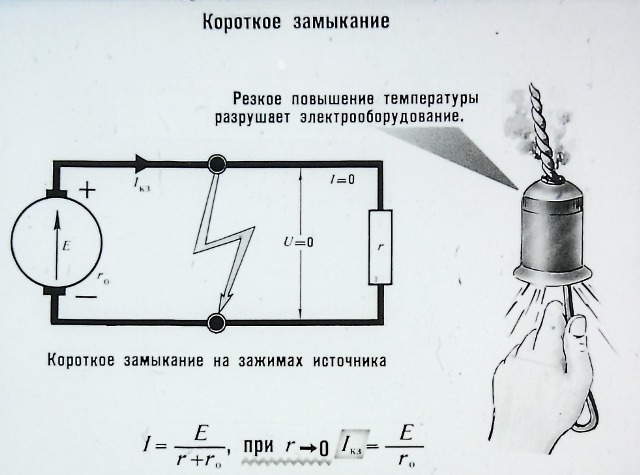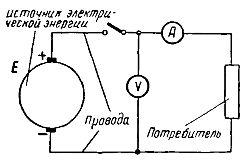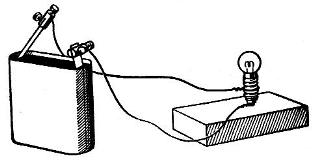Electric circuit and its elements
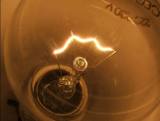
In an electric circuit, there must be a source of movement of electrically charged particles, which is called an electric current. In other words, electric current must have its own pathogen. Such an exciter of current, called a source (generator), is an integral part of an electrical circuit.
Electric current can cause a variety of effects in nature—for example, it causes incandescent light bulbs to glow, drives heating devices, and electric motors. All these devices and devices are called receivers of electric current. Since current flows through them, that is, they are included in an electrical circuit, receivers are also elements of the circuit.
The flow of current requires that there be a connection between the source and the sink, which is accomplished by means of electrical wires, which are the third important component of an electrical circuit.
Electric circuit — a set of devices designed for the passage of electric current. The circuit is formed by energy sources (generators), energy consumers (loads), energy transmission systems (wires).
An electrical circuit is a set of devices and objects that form a path for electricity, electromagnetic processes that can be described using the concept of electromotive force, current and voltage.
The simplest electrical installation consists of a source (galvanic cell, battery, generator, etc.), consumers or receivers of electrical energy (incandescent lamps, electric heaters, electric motors, etc.) and connecting wires connecting the terminals of the voltage source to the terminals of the consumer. These. electrical circuit — a set of interconnected sources of electrical energy, receivers and wires that connect them (transmission line).
The electrical circuit is divided into internal and external parts. The source of electrical energy itself belongs to the internal part of the electrical circuit. The external part of the circuit includes connecting wires, consumers, knife switches, switches, electrical meters, that is, everything that is connected to the terminals of the source of electrical energy.
Electric current can only flow in a closed electrical circuit. Breaking the circuit at any point causes the electric current to stop.
Under Electric circuits with direct current in electrical engineering, they mean circuits in which the current does not change its direction, that is, the polarity of the EMF sources, in which it is constant.
Under Electric circuits for alternating current mean circuits in which a current flows that varies with time (cf. alternating current).
The sources of power for the circuit are galvanic cells, electric accumulators, electromechanical generators, thermoelectric generators, photocells, etc. In modern technology, electrical generators are mainly used as sources of energy. All power supplies have internal resistance the value of which is small compared to the resistance of other elements of the electrical circuit.
DC receivers are electric motors that convert electrical energy into mechanical energy, heating and lighting devices, electrolysis plants, etc.
As auxiliary equipment, the electric circuit includes devices for turning on and off (for example, switches), instruments for measuring electrical quantities (for example, ammeters and voltmeters), protective devices (for example, fuses).
All electrical receivers are characterized by electrical parameters, the main ones being voltage and power. For normal operation of the electrical receiver it is necessary to maintain Rated voltage.
The elements of the electrical circuit are divided into active and passive. YES active elements of the electrical circuit include those in which EMF is induced (EMF sources, electric motors, batteries during charging, etc.). YES passive elements include electrical receivers and connecting wires.
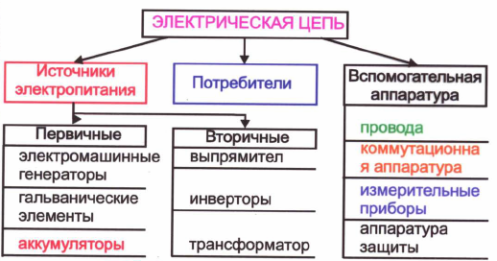
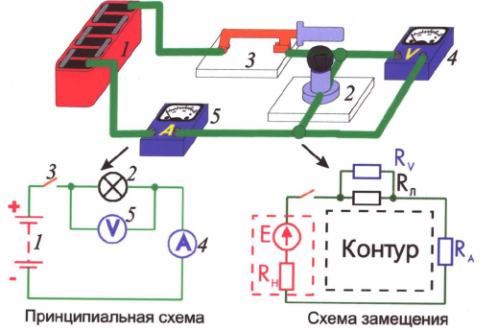
Circuits are used to conventionally represent electrical circuits. On these diagrams, the sources, receivers, wires and all other devices and elements of the electrical circuit are indicated using conventional symbols (graphic designations) made in a certain way.
According to GOST 18311-80:
Power supply circuit - an electrical circuit containing elements whose functional purpose is the production or transmission of the main part of electrical energy, its distribution, transformation into another type of energy or into electrical energy with other parameter values.
Auxiliary circuit of an electrical product (device) — an electrical circuit for various functional purposes, which is not a power electrical circuit of an electrical product (device).
Electric control circuit — an auxiliary circuit of an electrical product (device), the functional purpose of which is to activate electrical equipment and (or) individual electrical products or devices or to change the values of their parameters.
Electrical signal circuit — an auxiliary circuit of an electrical product (device), the functional purpose of which is to activate signaling devices.
Electrical measuring circuit — an auxiliary circuit of an electrical product (device), the functional purpose of which is to measure and (or) register parameter values and (or) receive information about the measurements of an electrical product (device) or electrical equipment.
According to topological characteristics, electric circuits are divided into:
-
for simple (single-circuit), two-node and complex (multi-chain, multi-node, flat (flat) and volumetric);
-
two-pole, with two external outputs (two-pole and multi-pole, containing more than two external outputs (four-pole, multi-pole).
Sources and receivers (consumers) of energy from the point of view of circuit theory are bipolar, since two poles through which they transmit or receive energy are necessary and sufficient for their operation. One or another two-terminal network is called active if it contains a source, or passive — if it does not contain a source (left and right parts of the circuit, respectively).
Devices that transmit power from sources to receivers are four-pole because they must have at least four clamps to transfer power from the generator to the load. The simplest device for transmitting energy is wires.
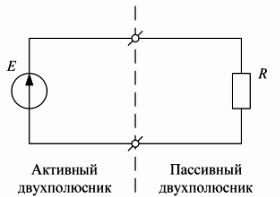
Active and passive two-terminal networks in the electrical circuit
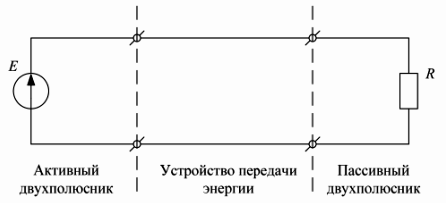
Generalized equivalent circuit diagram
Elements of an electric circuit that have electrical resistance and are called resistors are characterized by the so-called current-voltage characteristic — the dependence of the voltage at the terminals of the element on the current in it or the dependence of the current in the element on the voltage at its terminals.
If the resistance of an element is constant at any value of the current in it and any value of the voltage applied to it, then the current-voltage characteristic is a straight line and such an element is called a linear element.
In general, resistance depends on both current and voltage… One reason for this is the change in resistance of a wire when current passes through it due to its heating. As the temperature increases, the resistance of the conductor increases. But since in many cases this dependence is insignificant, the element is considered linear.
An electric circuit whose electrical resistance of the sections does not depend on the values and current directions and voltages in the circuit is called a linear electric circuit... Such a circuit consists only of linear elements and its state is described by linear algebraic equations.
If the resistance of a circuit element depends significantly on current or voltage, then the current-voltage characteristic is non-linear, and such an element is called a non-linear element.
An electric circuit whose electrical resistance of at least one of the sections depends on the values or directions of currents and voltages in this section of the circuit is called non-linear electric circuit… Such a circuit contains at least one nonlinear element.
In describing the properties of electric circuits, a relationship is established between the values of electromotive force (EMF), voltages and currents in the circuit with the values of resistances, inductances, capacitances and the method of circuit construction.
When analyzing electric circuits, the following topological parameters of the circuits are used:
- branch - a section of an electric circuit through which the same electric current flows;
- node - the junction of the branches of the electrical circuit. Usually, the place where two branches are connected is not called a node, but a link (or switchable node), and a node connects at least three branches;
- circuit — a series of branches of an electric circuit forming a closed path, in which one of the nodes is both the beginning and the end of the path, and the others meet only once.
Old educational tape. One of the 7 parts of the old "Electrical Engineering with the Basics of Electronics" educational tape, released in 1973.from the school supplies factory:
Electric and magnetic circuits with direct electric current
